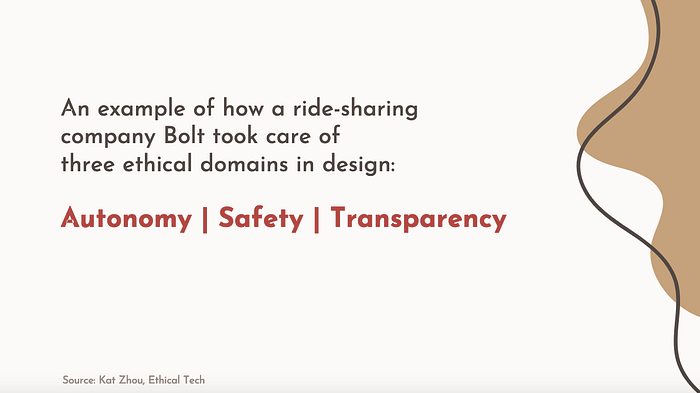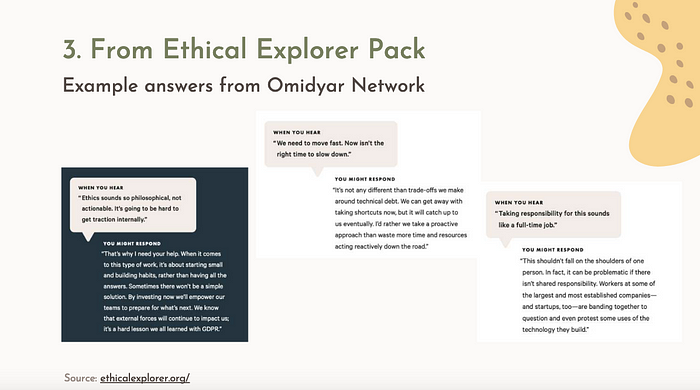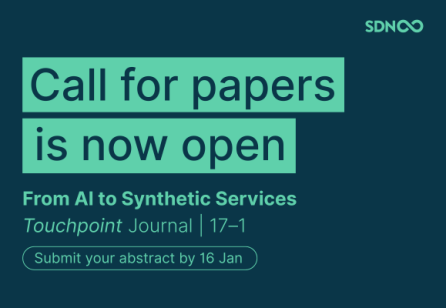
On Tuesday, August 10th, the SDN New York Chapter was delighted to host service designer & researcher Nata Kostenko, design ethics enthusiast, former digital nomad, to talk about the exciting possibilities for a relatively new area in service design, Ethical Design. While the discipline is still in its nascent stages, Nata shared some examples of successful and not-so-successful uses of the practice of how businesses, products, and services that are looking to build from principles of fairness, diversity, and fundamental integrity towards product design and human-centered design might use “ethics” to engage their customers deeper.
First, I want to share a few essential resources and experts leading in the domain for those new to Ethical Design:
- Ethical Design Handbook by Trine Falbe, Kim Andersen, Martin Michael Frederiksen.
- Designer and futurist Cennydd Bowles’s works, his book Future Ethics, his studio NowNext leads in the emerging practices of Ethical Design and Speculative Design (a near cousin of ethics).
- Paul Boag, a popular voice for ethics in user experience design and optimization — Paul’s expertise focus are on an event in UX referred to as “dark patterns,” also known as “aggressive persuasion,” which Nata speaks in detail about in her presentation (please watch her keynote for further information).
A few tool kits links and resources that are useful as conversation starters as well as aiding in the development of ethical design practices are:
- Monitoring Checklist by Kat Zhou.
- Tarot Cards of Tech by Artefact.
- Ethical Explorer Pack by Artefact.
Virtual tools for real-time collaboration and digital-first visual collaboration white-boarding include:
So let’s get started by an initial look at a bit of theory around ethical design from Nata’s presentation.
Ethical Design — Where are we, and where are we going today? And which term (s) should we use?
Fair, just, responsible, diversity, equity, safe, belonging, sustainable, ethical, integrity, mindful, humane.
Businesses, products, and services grow from a principle of fairness and fundamental respect towards everyone involved. Fairness and respect are essential values when thinking about ethical design.
What about context? Cultural differences, native vs. non-native speakers. Can we imagine a common vernacular around ethics? Perhaps, a good exercise for organizations working on a worldwide scale to visualize a global ethics taxonomy?
“A manual for ethics is an oxymoron if you’re after bullet-point instruction, you’ll be disappointed,” claims Cennydd Bowles, author of Future Ethics, founder of NowNext. Note: Bowles’s book offers a more profound and complex perspective of ethics in design — context. Context is crucial for ethical design, he states. I agree!
Also, Nata’s research shares an early use of commonly preferred terms that seem to transcend language or cultural barriers; words like ethical, mindful, and humane span a more comprehensive global vocabulary.
“While we can also get quite philosophical with our definitions, no one can answer our ethical problems,” says Nata.
Fair, just, responsible, diversity, equity, safe, belonging, sustainable, ethical, integrity, mindful, humane.
What terms would you use?
The challenge next also becomes how to make design an inherently ethical activity. What are the steps to ethical innovation, moral creativity, good design, integrity as a professional and human?
Nata introduces three theories here:
- Virtue Ethics: I have these traits, so I act in alignment with them.
- Deontology: I have these duties, so I act according to them.
- Consequentialism: I analyzed possible results; here is what I’ll do.
And relevant examples of forward-thinking ideas and companies engaging their customers with integrity and respect.
(A few links for further exploration on Deontology, a theory suggesting actions are good or bad according to a clear set of rules. Consequentialism, an idea that indicates an effort is good or bad depending on its outcome.)
Industry examples that make a case for good (ethical) design:

(1) A ride-sharing start-up company, Bolt (Estonia) — similar to Lyft and Uber is one excellent example of best practices of the three ethical domains in moral creativity — ethical tech: Autonomy. Safety. Transparency.
Bolt is also reportedly the first service to introduce women-only ride-share options — their case study of South Africa is an example of contextual ethical design. Of course, this type of segmentation can open up unknown layers of various ethical concerns in alternate cultures.


(2) Another example is HEY (a new email service from Basecamp), primarily used in Europe. HEY claims good ethical design by caring about your privacy while at the same token taking a neutral stance on politicizing ethics with privacy — “we don’t have to solve deep social problems, chime in publicly whenever the world requests our opinion on the major issues of the day, or get behind one movement or another with time or treasure.”
Can you have it both ways?
Moral sensitivity — HEY attempts to approach ethical design with moral sensitivity.

(3) A third example is Wise Ltd. A virtual (global) banking card. Wise believes their customers should also be shareholders. Digital currency, money, with moral values.
Moral advocacy: Wise Ltd. sets an excellent example of moral advocacy in ethical design.
Bolt, Hey, Wise: These examples appear to be pioneering, early adopters of ethical design practices, where both designers and companies design to build a fairer future.
Next, Nata shared a case study of diversity as an ethics issue and a more in-depth expression of the (anti-ethical) UX optimization tactic “dark patterns.”
Watch Nata’s presentation for more information on:
Diversity is an ethics issue, a case study of HyperGiant Industries, Will Griffin.
UX scenario of Dark Patterns by ethics expert Paul Boag — how specific “aggressive persuasion” tactics damage entire business ecosystems. More examples of dark patterns within tech at this link here: https:/www.ruinedby.design/
In summary: the logic for dark patterns works as hidden tactics in UX optimization predominantly during a purchase experience, like when the system automatically adds one smaller or cheaper thing into your basket — ‘sneak’ one more item into carts as people are buying, they pay more, the price goes up. The customer gets tricked into buying more!
As you may intuit from a few of these scenarios above, ethical thinking impacts long-term company value for the better or worse. How can service designers help?

Next and as an integrated part of this keynote, Nata invited us (the audience) to engage in exercises to uncover why and how values are essential ethics concepts. How value-driven creativity can impact your design — customer journey, product features, etc. Helpful frameworks and activities that stakeholders can use.

True story. You get an invitation to speak at the conference on the topic you find meaningful. One day before the event, you find out that the main sponsor is a gambling company. What do you do? Would you speak at the conference? And why? Or would you choose not to talk at the conference? And why not?
This exercise helps you think of unethical situations — what will you take responsibility for as a designer?
A quick recap on this collaborative Miro exercise:
There weren’t many motivations for yes. Interesting point of view to highlight for those that said yes:” Are there safeguards in place to help if addiction becomes an issue?” “I would speak because of obligation; however, it may include a small segment on the dangers of *addictive design* just to highlight the concern.”
Participants felt that if they were to reconcile their ethics, they would find a way to voice their point of view and use the opportunity as a teaching moment.
Here is what Nata did and why.
“Yes, I did participate in the conference. First, because it was an all-female panel and I’m supporting female businesses, female empowerment was essential for me… Because I was also the moderator, I adjusted the agenda, and we discussed ‘dark patterns,’ how to design for Trust and how people in their companies can apply those methods — one of the keynote speakers happened to be from that gambling company (sponsor), which led to a productive panel discussion.”
The following example is a kind of ethical disclaimer. This exercise is a good look at communicating moral action while setting the tone of a meeting or project.
“You’re in a team meeting and usually record them — however, this time, the host didn’t ask for consent before hitting ‘record.’”
Would you say something about the recording? And why? Or would you choose not to say anything about the recording? And why not?
A quick recap on this collaborative Miro exercise:
Participant comments from prompt (s); ‘Yes, I’d send a direct message first….” “I would give a heads up.” “I would say something towards the end of the meeting, express my concern about being recorded.” “It may be a mistake; give them a chance to clarify….” “Sorry to interrupt; looks like this meeting is being recorded — maybe I missed the heads up, so I want to give others a choice about this.”
- Choice was an exciting insight from this activity. Your choice to speak up or not also depends on the culture of the company. Once again, context matters in ethics.
The No answers were mostly around etiquette (vs. ethics), like not interrupting a meeting in progress.
What Nata did and Why?
“I decided to speak up; it felt weird. But I did it. Little things add up. Whether you decide to say something or not to say something, it’s important to notice your intention — the whole activity of our consciousness is relevant. You/we build it from smaller steps and move onward to bigger issues.”
In our next and final few exercises, Nata asked us to challenge ourselves, tackle ethical issues in a fun, creative way — “let’s do ethical!”

This activity had three prompts:
(1) Ethics sounds so philosophical, not actionable, it will be hard to get traction internally.
(2) We need to move fast. Now isn’t the time to slow down.
(3) Taking responsibility for this sounds like a full-time job.
A quick recap on this collaborative Miro exercise:
Participant replies from the Miro prompt on (1) “Trust is very valuable. How much money does a company lose each year from lack of Trust.” “Focusing on the cost of ethical lapses is helpful.” “You don’t want to get sued.” “IOS or Android requiring compliance, GDPR, CCPA, other pending privacy regulations are an issue as well.”
Participant replies from the Miro prompt on (2) “Lawsuits slow things way down.” “Risk mitigation is worth the time.”
Participant replies from the Miro prompt on (3) “Ethics depend on many viewpoints being considered…” “Take small steps (towards responsibility).” “Hiring someone full-time (Chief Ethics Officer).” “Create a Slack group, posting about ethical vacancies, like ethical tech, ethical developers, data scientists…” “In a perfect world, there will be no need for ethical….”
- A new role like Chief Ethics Officer was a fascinating insight from this activity and a sign of the times!
Next and final few exercises:
“In 1–2 words, how do you feel about ethical design?”

A quick recap on this collaborative Miro exercise:
Participant replies from the Miro prompt: “So important!” “I love the reflections, very inspiring to do more. Thank you!” “Happy to have found allies and happy to know lots of people care about ethics and are brave!” “A duty to serve beyond profits and growth; it’s about making a better world for all.”
Nata: “Ethical design should be baked into the design process. Yes, find allies. Speak up about things. Always be mindful of people impacted by the service ecosystem.”
So what else can we say or envision on the horizon for ethical design? What more questions can we ask? What kind of questions?
Here Nata leads us through a final self-reflection exercise; in her work, she says, reflective activities are crucial at the beginning and end of each project. “It’s important to include yourself,” she says; “it’s also ethical Human-Centered Design.”
- Side note: here is an excellent read by WIRED magazine on human-centered design, what it is and why it matters. More resources on HCD here: https://www.ideo.com/post/design-kit
Self-reflection activities for ethical design:
Nata: “We have two project meetings a week; I will make sure to ask at least one question (to the team) that bothers me (about the project or process).”
A quick recap on this self-reflection collaborative Miro exercise —
Reflections for the beginning (of a project): “I know the KPIs for the project.” “KPIs don’t go against my moral stance.” “We have the definition of ‘done for the project.” “Be very attentive to the new projects kick-off phase.” “I have a personal development goal for the project.” “Write a letter to my future self on how I want this project to go.”
Reflections for the end of a project: “Check the letter I wrote to myself at the beginning.” “Conduct regular reflections.” “Complete normative design canvas to keep building my ethics muscle.” “Check what my performance & role on the project was.” “Combine that knowledge with my cycle phase data.”
- One insight from this exercise is the idea of “Normative Design Canvas” that one participant alluded to. Here is a brief definition of that field of philosophy (also known as Normative Design Scheme), which complements ethics and its broad knowledge base.
In essence, almost every ethics-related event begins with paradoxical stories. Shaping a moral stance becomes a daily ethical practice — understanding why you do what you do, why you think what you think.
Takeaways and inspirations:
- “We build ourselves every day.” “Responsibility is about asking: What choices are compatible with the parts of my identity?” “Could I be a person who can do that?” “I care about other human beings and think how my actions affect other people. I help others expand their capabilities.”
— Inspired by Ariel Guersenzvaig - Gartner, a leading research firm, identified Trust and Ethics as one of the main trends accelerating in the past few years.
- Nata also recommended the movie, The Circle with Emma Watson along these same lines of thinking.
Fair, just, responsible, diversity, equity, safe, belonging, sustainable, ethical, integrity, mindful, humane. Whichever word or term calls to you — a moral economy is emergent, trust and ethics are the new currency, and design matters — specifically ethical design.
Thank you for joining us for our monthly event. I think this is something that we all need to be talking about, and the more we can find community and talk about this together and share resources, share best practices, the better. I think (ethics and ethical design) is a space that is going to need more and more attention as we grow as designers in general; I think it’s becoming more and more relevant that we understand ethics and understand how we have a seat at the table as decision-makers and influencers.
Recap article by Jeannie Joshi, Creative & Design Director based in New York, NY. If you are looking for event resources check out the SDN NYC website or go straight to the video recording on their YouTube channel.
Find this content interesting or useful? Follow the SDN New York Chapter on Instagram, LinkedIn, Twitter, and/or Medium to stay connected. Anyone is welcome to join their Meetup group and events. You can also find them on the global Service Design Network website — learn more about the larger SDN community there as well.








Share your thoughts
0 RepliesPlease login to comment